Horsepower on the Prairie
Author & photography
- Mattijs Diepraam
Date
- August 28, 2010
Related articles
- Jean Behra - The fighting man, by Mattijs Diepraam
- Jo Bonnier - Bonnier takes BRM by the horns, by Felix Muelas/Leif Snellman/Mattijs Diepraam
- Gordini - Nimble, elegant, ultimately French, by Mattijs Diepraam/Felix Muelas
- Robert Manzon - The first musketeer, by Rémi Paolozzi
- Stirling Moss - How Stirling got his Mercedes breakthrough, by Mattijs Diepraam/Felix Muelas
- Rouen-les-Essarts - Arguably the greatest French circuit of all, by Gareth Evans
- André Simon - The relay runner, by Rémi Paolozzi
- Maurice Trintignant - Le Petoulet's colourful career, by Mattijs Diepraam
- R R C Walker Racing Team - Hallowed privateer, by Mattijs Diepraam/Felix Muelas
Where?Caen, Boulevard Yves Guillou When?August 10, 2010 |
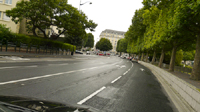 |
Why?
Park circuits were a fairly common occurrence in early and mid 20th century motor racing. Usually, they were set out on a course using the park roads, such as in Montjuich Park, Valentino Park or Albert Park. At Caen in France, however, the cars raced around the park, as the ACO picked out the park’s perimeter road on which to stage their event. We visited ‘the Prairie’ of Caen, where horse jockeys still race their steeds on the purpose-built oval dirt track that is making up over half of Caen’s city park, to see what challenge once lay ahead for the F1 and F2 drivers taking part in the Grands Prix de Caen of the fifties.
Caen is the capital of the Calvados department in the middle of the Lower Normandy region and is easily identified as a war-struck place. Its siege and consequent destruction by Edward III during the Hundred Years’ War preceded the crushing defeat of the French at Crécy, a few days later on the 1346 calendar. Caen’s second demolition came almost six centuries later. Situated a mere half day’s march from the shores along the Channel where on June 6, 1944 the allied forces began their invasion of occupied France, Caen found itself in the middle of the Battle of Normandy, during which the British for over a month failed to capture the city.
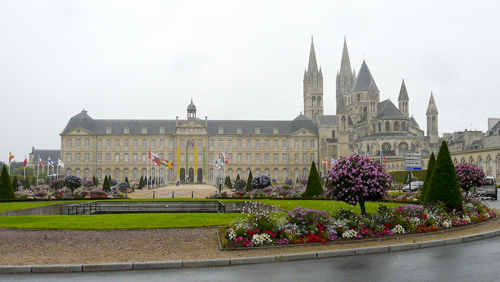
The Abbaye aux Hommes in Caen, which today functions as the new town hall. (photo 8W)
The results of Operation Charnwood – which entailed bombing the town and its German masters into the ground – are still very much visible. The city is littered with semi-ruined churches and functional fifties and sixties architecture, even though its foremost treasures have been mercifully spared. The town’s citadel, brooding darkly above the city centre as it has done for centuries, harks back to Caen’s glory years, sparked off by its founder, a man of no lesser fame than William the Conqueror. The bastard son of the Duke of Normandy who sailed to England to defeat the man who he believed had betrayed him and claim the crown that he thought was rightfully his is buried in the church of the Abbaye aux Hommes, one of the two abbeys William ordered to be built in repentance for marrying his cousin Mathilda of Flanders. Today, having remained intact during the post-D-Day rush, the abbey functions as the town hall.

The town was built around William the Conqueror's castle. (photo 8W)
On the slopes of the Calvados – from the rocky Norman Switzerland to the archetypal Norman countryside of the Bocage Virois or the Pays d’Auge – several fully rebuilt villages are a reminder of the annihilation that was needed to liberate Europe. For the rest, the region has gone back to what it does best, as its numerous apple orchards will testify, all for the production of cider and the strong stuff known as Calvados. Caen itself is a vibrant place, even in the dreary weather that plagued the town during our visit. It is buzzing with technology firms attracted to its renowned university – one of the oldest in France – and its three campuses linked by an innovative guided bus system. As Caen also hosts a school of arts and a national engineering school, you can see why young people dominate the town’s street life.
Caen was still fully in the process of re-inventing itself when it decided that attracting the top-line Grand Prix drivers of the day would be a good idea to advertise the city. In the early 20th century Caen had already provided the stage for the Coupe de Normandie, held on a huge triangular track between Bayeux, Tilly-sur-Seulles and Carpiquet, which today is Caen’s airport to the west of town. The starting point was the fork called La Maladrerie, just outside Caen, in Saint-Germain-la-Blanche-Herbe. In 1908 the cars had to brave a 62km circuit, on what are now the N13 (and partly the D613), D6 and D9. The race was won by Barriaux on an Alcyon. In 1909 this was slightly shortened to a mere 59km by the D13 cut-off from Tilly-sur-Seulles to Fontenay-le-Pesnel. Georges Boillot won the 1909 race on a Lion-Peugeot, easily fencing off the attentions of Thomas on a Le Gui and Giuppone on a Lion. Boillot returned in 1910 but this time was narrowly beaten by Jules Goux's similar car, with Delpierre in a De Dion-engined Corre La Licorne the only other competitor.
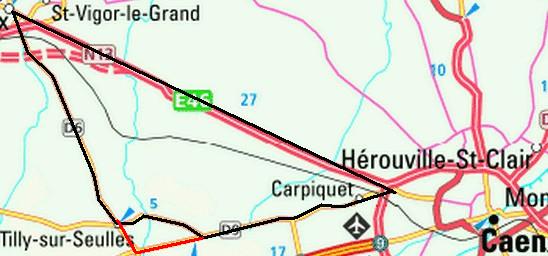
Caen's 1908-1910 circuit layout. (GEL Track Database)
For its Grand Prix de Caen, the city park was chosen. Called la Prairie, it borders on the river Orne and is surrounded by the Boulevard Yves Guillou, two tree-lined esplanades and the main connection road between the western and southern parts of town. Prairie is quite an apt name since it is hard to find any shade in this large open space to the south of the city centre. That’s not a result of World War II, it’s always been that way. The best part of the Prairie is occupied by the hippodrome and if people today speak of the Grand Prix de Caen, it’s about horse racing. Having said that, that particular race course was already firmly there when the first Caen GP for motor cars was hosted in 1952. The other side of the Prairie centers around the Nouveau Bassin, a pond for the city birds to take a nip and a rest. No wonder that the first Circuit de Vitesse at Caen in 1952 was advertised through its visibilité totale du parcours.
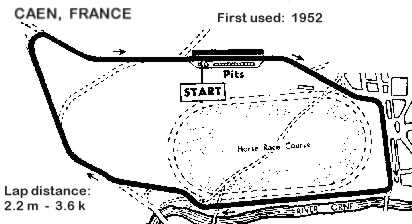
Caen's 1952-1958 circuit layout. (GEL Track Database)
It’s the location of this Nouveau Bassin that takes away from the overall rectangular shape of the Prairie and will have made the motor racing circuit a bit more interesting to circumnavigate at speed. While at Valentino Park the track was only partially using the avenue alongside it, the Caen circuit is fully composed of the park’s perimeter road. In that way, it mirrors the Leipzig Stadtpark layout but a comparison with some of Britain’s most famous airfield circuits also springs to mind, since Silverstone and Goodwood also have their origins as perimeter tracks.
The 2.2-mile Circuit de la Prairie will have been fast and daunting, its long straights connected by two 90-degree corners and two more challenging corners – one a flowing arc of approximately 60 degrees, the other a rather sharp hairpin. Two of the straights aren’t in fact straight at all. At the north side, the Boulevard Yves Guillou meanders along the Prairie, while in the west the Boulevard des Balades provides a short connection between the Chemin de la Cavée that is the fast south-west corner of the circuit, and the hairpin connecting with the Boulevard Yves Guillou. The Cavée corner will definitely have been much more exciting than the two 90-degree corners at the other end of the circuit. At the Passerelle de l’Orne, the pedestrian bridge across the river, it starts with a fast right-left kink upsetting the balance of the car before it sets of on the long winding curve towards the hairpin. The east and south straights would have its own challenges, though. On the July dates of the Caen GP, both the short blast along the Cours du Général De Gaulle and the Cours du Général Koenig that follows will certainly have had sudden rays of sunlight bursting through its leaf-covered ceilings, momentarily blinding the drivers.
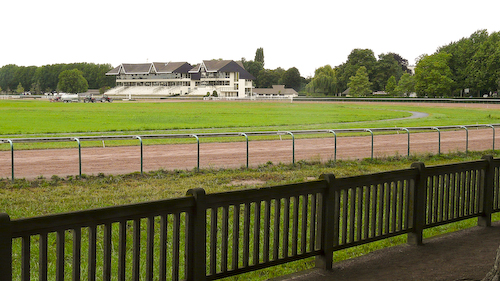
A view on the Hippodrome stadium. The startline would be at the back of the grandstand. (photo 8W)
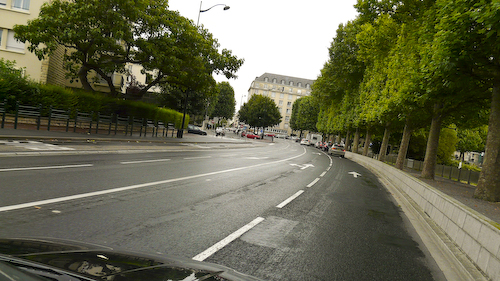
Towards the first corner. (photo 8W)
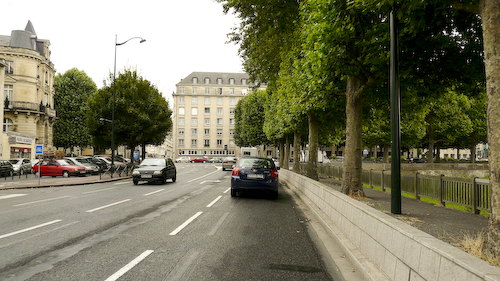
Nearing the first corner. (photo 8W)

The first corner itself, where Boulevard Yves Guillou connects with the Cours du Général de Gaulle. (photo 8W)

Halfway down the Cours du Général de Gaulle. (photo 8W)
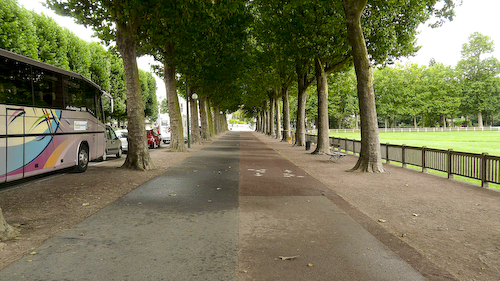
The spectators would be able to see the action from the sidewalk, right from under the trees. (photo 8W)

Other than the bare statistics, not much is known about the history of the Caen GP, its colour and its value to the region. Its first edition took place in 1952, when it was open to the Formula 2 cars that had become the eligible World Championship category. Between 1954 and 1958 a late-July date (late August in 1956) would provide the scene for a 2.5-litre Formula 1 race that was usually reasonably well entered, no doubt thanks to the Automobile Club de l'Ouest playing their part in the organisation. The 1955 Le Mans disaster caused the 1955 race to be cancelled. The II Grand Prix de Caen in 1953 was a sportscar race. By 1958, the event had held out as one of the few remaining non-championship events in continental Europe, along with Syracuse, but in 1959 Britain became the only country to host any meaningful non-points F1 race. Formula 1 downgrading to the former F2 rules in 1961 meant the re-introduction of the wealth of non-championship events but Caen would not be among those.
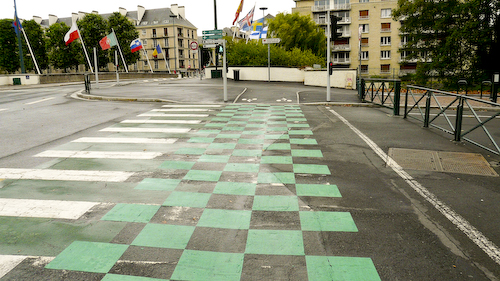
The second 90-degree corner, where the Cours du Général de Gaulle connects with the Cours du Géneral Koenig. (photo 8W)
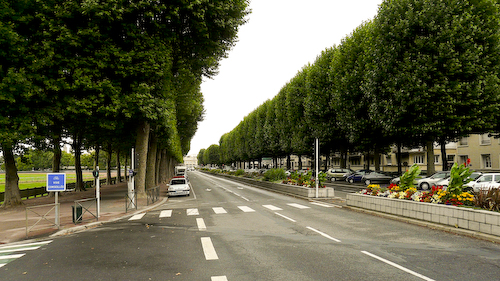
Looking back down the short de Gaulle straight. (photo 8W)
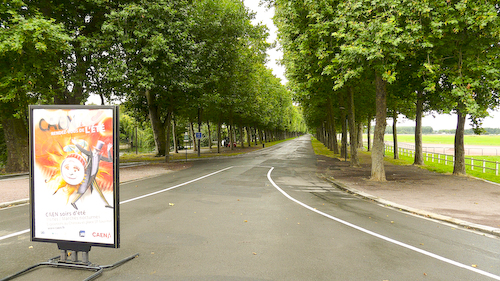
A look down the Cours du Géneral Koenig, now a walkway along the river Orne. (photo 8W)
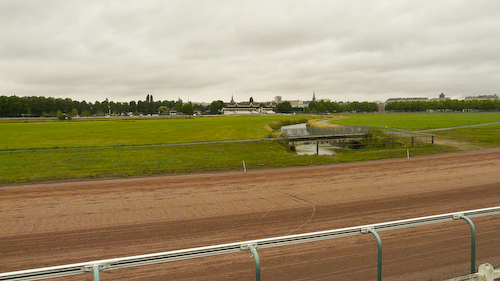
The cars would go side-by-side with the hippodrome track all the way down the Cours du Géneral Koenig. (photo 8W)
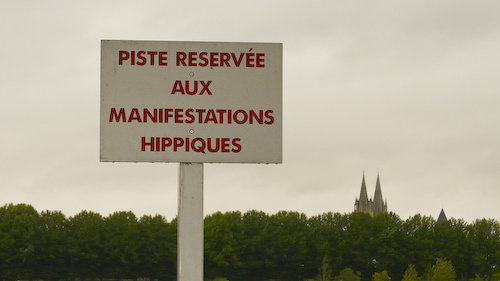
The racing drivers probably wouldn't have bothered with this sign. (photo 8W)
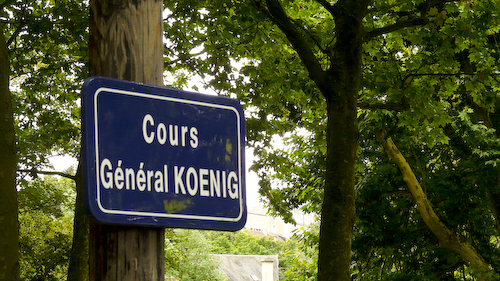
The first Caen GP was a purely national affair. A Formula 2 race since it was headlined by Louis Rosier’s Ferrari 500 and the Gordini T16s of Behra and Trintignant, it also welcomed a fleet of DB-Panhards, Marcel Balsa’s BMW-based special and a Simca special called ‘La Pintade’ driven by Theo Martin. Two other Simca-Gordinis were run by Harry Schell and Jacques Pollet. The field was completed by Armand Philippe in Rosier’s Ferrari 166, the Cisitalia D46 of Jean Morel and the Alta-powered HWMs of Yves Giraud-Cabantous and André Simon. The DB-Panhard was an unusual car. With two 750cc Panhard engines, one powering each axle, Charles Deutsch and René Bonnet created a twin-engine, four-wheel-drive single-seater that could only be compared to the pre-war Fuzzi hillclimber or the early post-war Fageol Twin Coach Indy machine, both outlandish concepts in their own right. Even by adding up the capacity of both Panhard engines, the car remained well within Formula 2’s 2-litre limit so it’s hard to see why DB chose to go this route in 1951. The five DB-Panhard drivers of the day – Michel Aunaud, Louis Pons, Pierre Chaussat, Alphonse de Burnay and René Bonnet himself – were well off the pace set by Trintignant, Aunaud the best of the DB runners, completing 66 of the 75 laps. At the front Trintignant – straight from the British GP at Silverstone, as was Schell – had qualified on pole, ahead of Rosier and Giraud-Cabantous, and a good two hours and 15 minutes later found himself the winner, easily beating his young team mate Jean Behra. Rosier’s Ferrari finished third, over two minutes down.
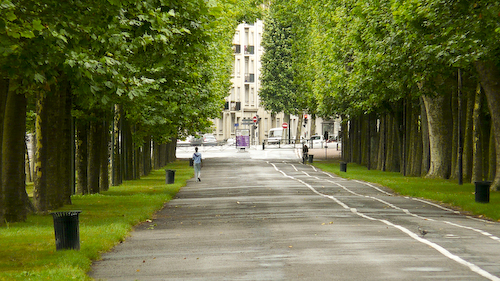
Looking back down the Cours du Géneral Koenig from the Cavée side, it is clear to see how bumpy the track would have been. (photo 8W)
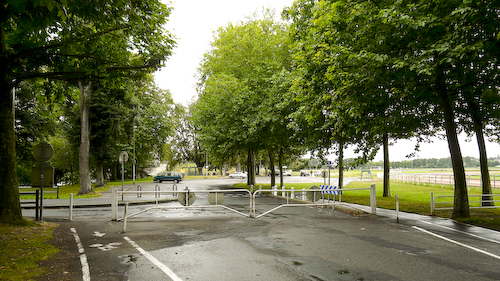
At the Passerelle de l'Orne, the most thrilling part of the circuit would start: the right-left kink along the Chemin de la Cavée. (photo 8W)
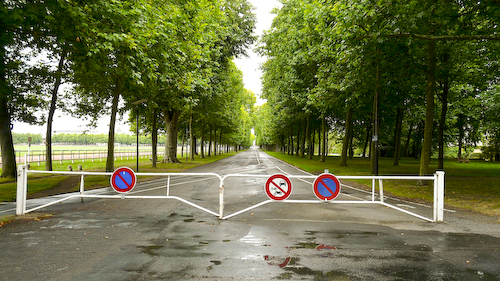
Today, cars are able to drive up to this gate at the Passerelle de l'Orne, coming from the Boulevard des Baladas, but that is as far as they can go. (photo 8W)

The cycling path along the Chemin de la Cavée follows the hippodrome's curve. (photo 8W)

The first part of the Chemin de la Cavée kink, looking back to the Passerelle de l'Orne. (photo 8W)
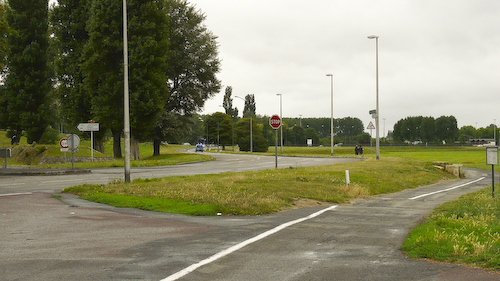
Seen in the clockwise racing direction, the Chemin de la Cavée kink straightens out into the Boulevard des Baladas. (photo 8W)
A proper Formula 1 race in 1954, the third Caen GP saw an entry that was less in number but brighter in quality. Now a Ferrari works driver, Trintignant travelled from Silverstone with his 625, while old-timer Rosier brought two private 625s for himself and Robert Manzon. Their main opposition would come from the works 250F of Stirling Moss and Prince Bira’s private example. Gordini entered three T16s for Behra, Clemar Bucci and Jacques Pollet, while the tenth and final entrant came from Argentina in the form of a works-supported Ecurie Maserati Argentino-run A6GCM for Roberto Mieres. He wasn’t to start though. When his Maserati engine blew up in practice, poor Roberto was sprayed with burning fuel and suffered severe burns. It was a miracle in itself that Mieres was back to racing three weeks later, still covered with bandages. Qualifying became a straight fight between the three works lead drivers, Moss, Trintignant and Behra, and it was ‘Le Petoulet’ who took pole by four tenths from Stirl and Jeannot. Trintignant and Moss fought it out on the Sunday as well after Behra crashed out on lap 4. He took over Pollet’s car and while he still finished third – of only five classified cars – he would be two laps down on Trintignant who eventually beat Moss by three seconds, nosing ahead three laps from the end, the pair having swapped the lead three times in the 211km race.
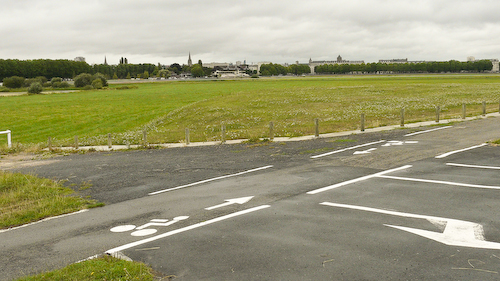
Caen on the horizon: the city's modest skyline seen from the Boulevard des Baladas. (photo 8W)
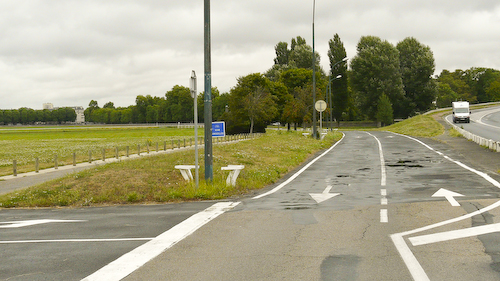
A good look backwards on the kink. (photo 8W)
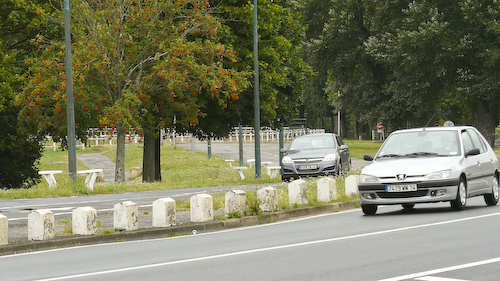
A bit further up on the Boulevard des Baladas, looking back towards the exit of the kink. (photo 8W)
The fourth Caen GP was definitely much more second-string, with Schell persuading Maserati to supply him with the single works trident entry. Gordini naturally provided works opposition, with cars for Manzon, Simon, Da Silva Ramos and Georges Burgraff, but the rest of the entry consisted of valiant privateers and the lone Emeryson-Alta that Paul Emery would race himself. Emery found two back-of-the-grid foes in the presence of two ageing F2 cars: Bill Morice’s Cooper-Bristol T23 and Aldo Pedini’s Scuderia Centro Sud-run Ferrari 500. Jean Lucas entered another Ferrari 500 under the quaint Circle los Amigos banner. Roy Salvadori headed a phalanx of private 250Fs, as his Gilby example would take on the similar cars of Louis Rosier, Horace Gould and Bruce Halford, the two Brits always happy to pick up the starting money in these lesser events while hoping for some prize money in the end as well. As it turned out, Rosier, Halford and Gould would receive none of it, as they all crashed out, along with Manzon in Gordini’s latest T32. Da Silva’s other T32 blew its clutch on lap 1 while Emery’s Alta engine succumbed on lap 6. This left victory as an easy prey for Schell who ran out the race a minute ahead of Simon and a lap clear of Salvadori.

Here, the big Chemin de la Cavée bridge road connects with the kink. (photo 8W)
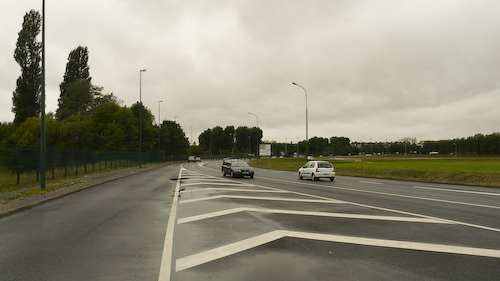
On the Boulevard des Baladas, looking ahead to the west hairpin. (photo 8W)

The west hairpin in full view. (photo 8W)
The fifth Caen GP’s entry number was once again in the low tens, and saw a much more competitive turnout. The Maserati privateers returned in full force with Halford and Gould joined by Piotti and Bonnier. 1956 winner Schell was back as well, now having been handed a BRM works drive after his own Maser gave up. The Bourne factory in fact sent two cars, the other P25 given to French hero Jean Behra, like Schell a Maserati driver in the championship events. What’s more, Salvadori brought the Cooper Car Co’s nimble new F2 machine along, with Jack Brabham and Tony Brooks tagging on in Rob Walker’s T43s. As ever, there was room for the enthusiasts as well, as the back of the grid was made up by Jean Lucas’s Alan Brown-run T43 and the embarrassingly slow Marc Rozier and his obsolete Ferrari 500. This time, it was to be a 300km race over 86 laps, expected to last for at least two hours. Brabham was already out after two laps, however, due to a failing magneto drive. On lap 29, Brooks, having been Behra’s closest nemesis in qualifying, fell by the wayside when his clutch gave up, and on lap 58, Behra’s last remaining threat was taken out when his team mate Schell blew up the engine in his BRM. Jean ran out the winner with a full lap in hand over Salvadori. It was the very first win for the hitherto luckless BRM P25. Halford, who had qualified a terrific fourth, completed a fruitful weekend by finishing a marvellous third, a mere 15 seconds adrift of the works Cooper and multiple laps ahead of Bonnier, Gould and Piotti in the other 250Fs.

The entire Boulevard des Baladas, looking back from the entry to the hairpin. (photo 8W)
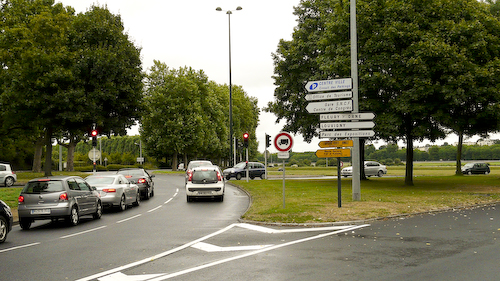
Today, the hairpin is part of a busy intersection. (photo 8W)
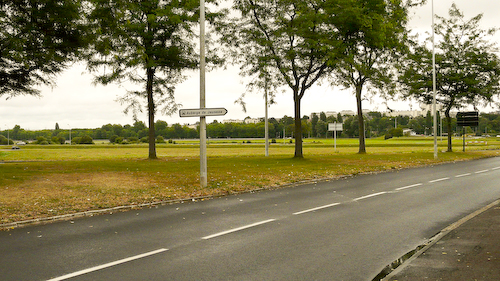
More Boulevard des Baladas, now with a good view of the entire Prairie. (photo 8W)
BRM repeated its Behra and Schell entry for the sixth and final Caen GP in 1958, and had to make it a race in itself to compete in the clashing British GP as well. Other GP drivers doing Silverstone on Saturday and Caen on Sunday were Jo Bonnier, in his own 250F again, Gerino Gerini in a Centro Sud 250F, Maurice Trintignant in Rob Walker’s T43, and Stirling Moss, swapping his Vanwall for Rob Walker’s new Cooper T45 in which he had already won the Aintree 200 in April. Vanwall team mate Stuart Lewis-Evans also made the trip and changed to BRP’s T43. Other private Coopers to make up the grid were run by George Wicken, Dick Gibson and Keith Ballisat while Les Leston brought John Fisher’s Lotus 12. Like Ballisat, he was out after the first lap, however, the former having lost a wheel while the latter crashed on the oil of his blown-up engine. BRM’s fortunes, already down in the 1958 season, took another dive when both Schell and Behra retired with mechanical failures. So it was Stirling Moss who grabbed an easy win for Rob Walker, leading home Bonnier’s Maserati by a lap. Halford repeated his 1957 performance by taking a competitive third, well ahead of a troubled Trintignant and Lewis-Evans.

The first part of Boulevard Yves Guillou, coming out of the hairpin. (photo 8W)
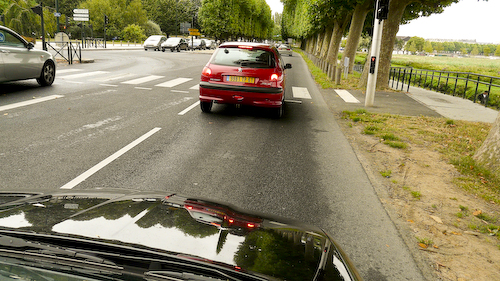
Driving back towards the start and finish line. (photo 8W)
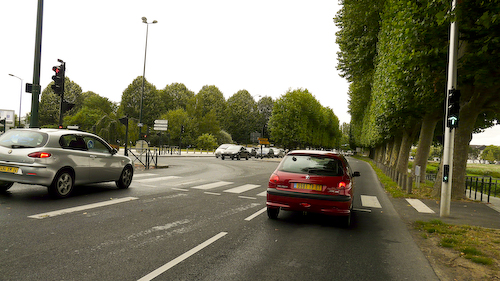
Almost full circle now... (photo 8W)
That was the end of Grand Prix racing in the town of Caen. Park and street racing weren’t over by a mile but Formula One cars would only return to Normandy when Rouen managed to attract the French GP to its famed road circuit at Les Essarts.
